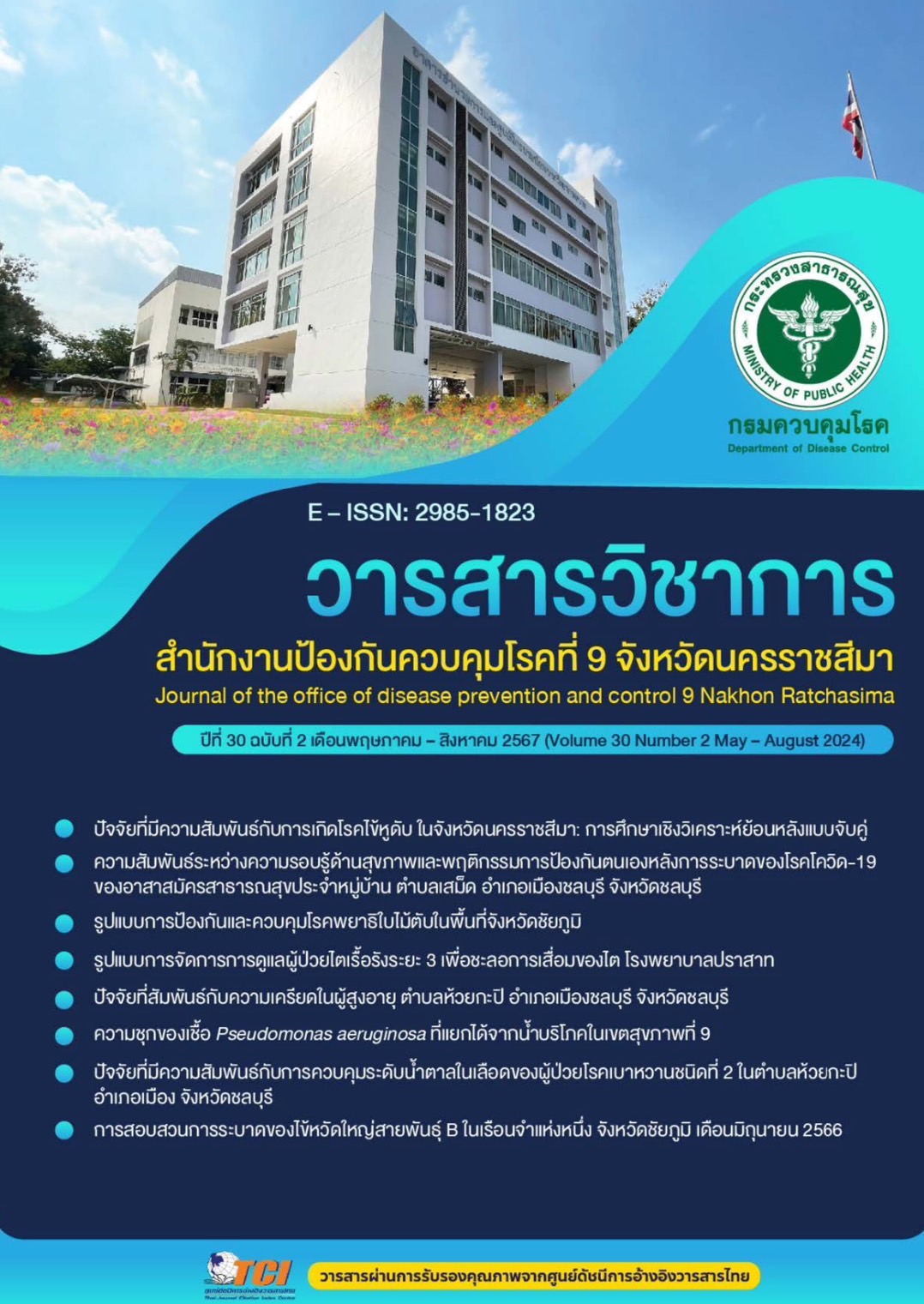ความสัมพันธ์ระหว่างความรอบรู้ด้านสุขภาพและพฤติกรรมการป้องกันตนเองหลังการระบาดของโรคโควิด-19 ของอาสาสมัครสาธารณสุขประจำหมู่บ้าน ตำบลเสม็ด อำเภอเมืองชลบุรี จังหวัดชลบุรี
คำสำคัญ:
ความรอบรู้ด้านสุขภาพ, พฤติกรรมการป้องกันตนเอง, หลังการระบาดของเชื้อโควิด-19, อาสาสมัครสาธารณสุขประจำหมู่บ้าน (อสม.)บทคัดย่อ
การวิจัยเชิงพรรณนาครั้งนี้ มีวัตถุประสงค์เพื่อศึกษาความสัมพันธ์ระหว่างความรอบรู้ด้านสุขภาพและพฤติกรรมการป้องกันตนเองหลังการระบาดของโรคโควิด-19 ของอาสาสมัครสาธารณสุขประจำหมู่บ้าน(อสม.) ตำบลเสม็ด อำเภอเมืองชลบุรี จังหวัดชลบุรี เก็บข้อมูลด้วยแบบสอบถามจากกลุ่มตัวอย่าง จำนวน 124 คน ที่ได้จากการสุ่มตัวอย่างแบบหลายขั้นตอน ซึ่งยังคงปฏิบัติงานหลังการระบาด ทำการวิเคราะห์ข้อมูลด้วยสถิติเชิงพรรณนา ได้แก่ ค่าความถี่ ร้อยละ ค่าเฉลี่ย ส่วนเบี่ยงเบนมาตรฐาน ค่ามัธยฐาน ค่าต่ำสุด และค่าสูงสุด รวมทั้งวิเคราะห์ข้อมูลด้วยสถิติเชิงอนุมาน ได้แก่ สหสัมพันธ์ของเพียร์สัน และการทดสอบไคสแควร์ ผลการศึกษาพบว่า ระดับความรอบรู้ด้านสุขภาพโดยรวมอยู่ในระดับดีมาก ร้อยละ 80.0 (=55.7, S.D.=4.0) โดยความรู้ความเข้าใจอยู่ในระดับถูกต้องที่สุด ร้อยละ 86.0 (
=55.7, S.D.=4.0) การเข้าถึงข้อมูลสุขภาพและบริการสุขภาพอยู่ในระดับดี ร้อยละ 75.7 (
=11.3, S.D.=0.6) ทักษะการสื่อสาร ทักษะการรู้เท่าทันสื่อ และทักษะการจัดการตนเองอยู่ในระดับดีมาก ร้อยละ 90.6 (
=13.6, S.D.=1.3) ร้อยละ 82.9 (
=12.4, S.D.=1.7) และร้อยละ 81.2 (
=12.1, S.D.=1.4) ตามลำดับ ส่วนทักษะการตัดสินใจอยู่ในระดับไม่ถูกต้อง ร้อยละ 45.2 (
=1.8, S.D.=1.0) พฤติกรรมการป้องกันตนเองจากเชื้อโควิด-19 ขณะระบาดและหลังการระบาดอยู่ในระดับดี ร้อยละ 76.6 (
=38.3, S.D.=3.6) ร้อยละ 78.5 (
=39.2, S.D.=3.1) ตามลำดับ นอกจากนี้ ความรอบรู้ด้านสุขภาพโดยรวมมีความสัมพันธ์กับพฤติกรรมการป้องกันตนเองหลังการระบาดของโรคโควิด-19 อย่างมีนัยสำคัญทางสถิติ (r = 0.445, p-value<0.01) อย่างไรก็ตาม ปัจจัยส่วนบุคคล ความรอบรู้ด้านสุขภาพในทักษะการจัดการตนเอง และทักษะการตัดสินใจไม่มีความสัมพันธ์กับพฤติกรรมการป้องกันตนเองหลังการระบาด ดังนั้น ควรออกแบบและจัดกิจกรรมเพื่อเสริมสร้างความรอบรู้ด้านสุขภาพของ อสม. การรู้เท่าทันสื่อและทักษะด้านการสื่อสาร เพื่อให้มีพฤติกรรมการป้องกันตนเองในการปฏิบัติงานมีความเหมาะสมยิ่งขึ้น
เอกสารอ้างอิง
กระทรวงสาธารณสุข. ประกาศกระทรวงสาธารณสุข. (ฉบับที่ 3) พ.ศ.2565 เรื่อง ชื่อและอาการสำคัญของโรคติดต่ออันตราย. ราชกิจจานุเบกษา. ฉบับประกาศทั่วไป เล่ม 139, ตอนพิเศษ 223 ง (ลงวันที่ 20 กันยายน 2565).
กองสุขศึกษา กรมสนับสนุนบริการสุขภาพ กระทรวงสาธารณสุข. การเสริมสร้างและประเมินความรอบรู้ด้านสุขภาพและพฤติกรรมสุขภาพ กลุ่มเด็กและเยาวชน อายุ 7-14 ปีและกลุ่มประชาชนที่มีอายุ 15 ปีขึ้นไป (ฉบับปรับปรุงปี 2561). นนทบุรี: โรงพิมพ์กองสุขศึกษา กระทรวงสาธารณสุข; 2561.
กาญจนา ปัญญาธร, กฤษณา ทรัพย์สิริโสภ, วัลภา ศรีบุญพิมพ์สวย, กมลทิพย์ ตั้งหลักมั่นคง, พรพิมล สรีสุวรรณ. ความรู้ ความเชื่อด้านสุขภาพและพฤติกรรมการป้องกันโรคโควิด19 ของอาสาสมัครสาธารณสุขประจําหมู่บ้านตําบลเชียงพิณ อําเภอเมือง จังหวัดอุดรธานี. วารสารการแพทย์โรงพยาบาลอุดรธานี. 2565;30(1):1-11.
กองสุขศึกษา กรมสนับสนุนบริการสุขภาพ กระทรวงสาธารณสุข. การเสริมสร้างความรอบรู้ด้านสุขภาพจาก อสม.สู่ อสค. กรุงเทพฯ:โอ-วิทย์; 2560.
Erdfelder E, Faul F, Buchner A. G*Power 3: A flexible statistical power analysis program for the social, behavioral, and biomedical sciences. Behavioral Research Method. 2007;39:175-191.
Hoerger M. Participant dropout as a function of survey length in internet-mediated university studies:implications for study design and voluntary participation in psychological research. Cyberpsychology, Behavior, and Social Networking. 2010;13(6):697–700.
เอกราช มีแก้ว, วัลลภ ใจดี, สุนิศา แสงจันทร์. ปัจจัยที่เกี่ยวข้องกับความรอบรู้ด้านสุขภาพและพฤติกรรมการป้องกันตนเองในการปฏิบัติงานเฝ้าระวังการระบาดของโรคติดเชื้อไวรัสโคโรนา 2019 ของอาสาสมัครสาธารณสุขประจำหมู่บ้าน อำเภอสอยดาว จังหวัดจันทบุรี. วารสารพยาบาล กระทรวงสาธารณสุข. 2564;32(1):74-87
Hinkle DE, William W, Stephen G.J. Applied Statistics for the Behavior Sciences. 4th ed. New York: Houghton Mifflin; 1998.
จุฑาวรรณ ใจแสน. พฤติกรรมการป้องกันโรค COVID-19 ของพนักงานสถาบันวิจัยวิทยาศาสตร์สาธารณสุข กรมวิทยาศาสตร์การแพทย์. กรุงเทพฯ: มหาวิทยาลัยรามคำแหง; 2563.
วิชัย ศิริวรวัจนชัย. ปัจจัยที่มีผลตอการปฏิบัติงานตามบทบาทของ อสม. ในการเฝ้าระวังและป้องกันโรคโควิด-19 อำเภอภูเพียง จังหวัดน่าน. มหาราชนครศรีธรรมราชเวชสาร. 2564;4(2):63-75.
พงศกร บุญมาตุ่น, วุธิพงศ์ ภักดีกุล, วรินทร์มาศ เกษทองมา. ปัจจัยที่มีความสัมพันธ์กับการเฝ้าระวังป้องกันโรคติดเชื้อไวรัสโคโรนา 2019 (COVID-19) ของอาสาสมัครสาธารณสุขประจำหมู่บ้าน (อสม.) อำเภอทุ่งฝน จังหวัดอุดรธานี. วารสารวิจัยและพัฒนาระบบสุขภาพ. 2565;15(2):300-321.
Nutbeam D. Health literacy as a public health goal: a challenge for contemporary health education and communication strategies into the 21st century. Health Promotion International Oxford University Press. 2000:15(3);259-267.
ดาวรุ่ง เยาวกูล, ปาจรีย์ อับดุลลากาซิม, นิภา มหารัชพงศ์. ความรอบรู้ด้านสุขภาพต่อพฤติกรรมการป้องกันโรคติดเชื้อไวรัสโคโรนา 2019 ของอาสาสมัครสาธารณสุขประจำหมู่บ้านในเขตสุขภาพที่ 6. วารสารวิจัยและพัฒนาระบบสุขภาพ. 2565;15(1):258-270.
วิรัญญา ศรีบุญเรือง, ธนรัตน์ นิลวัฒนา, ศิริโสภา สำราญสุข, กนกพร อนิรภัย, ศานสันต์ รักแต่งาม, ปวีณา สปิลเลอร์. ปัจจัยที่ส่งผลต่อพฤติกรรมการป้องกันการติดเชื้อ COVID-19 ในกรุงเทพมหานคร. วารสารมนุษยศาสตร์และสังคมศาสตร์ มหาวิทยาลัยราชภัฏอุดรธานี. 2564;10(1):195-196.
ประไพวรรณ ด่านประดิษฐ์, กรรณิกา เจิมเทียนชัย. ความสัมพันธ์ระหว่างความรอบรู้ด้านสุขภาพกับพฤติกรรมการป้องกันโรคโควิด-19 ผู้ติดเชื้อโควิด-19 ช่วงมีการระบาดปี 2564 และในไตรมาสแรกของ ปี 2565. วชิรสารการพยาบาล. 2564;24(2):70.
กันยารัตน์ อุบลวรรณ, นัยนา ภูลม, จีราภรณ์ ชื่นฉ่ำ, วิยะการ แสงหัวช้าง. การรู้เท่าทันสื่อเกี่ยวกับการระบาดของเชื้อไวรัสโคโรนา สายพันธุ์ใหม่ (COVID-19) ของนักศึกษาระดับปริญญาตรีของสถาบันพระบรมราชชนก. วารสารศูนย์อนามัยที่ 9. 2566;17(1):354-367.
อุไรรัตน์ คูหะมณี, ยุวดี รอดจากภัย, นิภา มหารัชพงษ์. ความรอบรู้ด้านสุขภาพกับบทบาทของอาสาสมัครสาธารณสุขประจำหมู่บ้าน (อสม.) ในการป้องกันโรคเรื้อรัง. คณะสาธารณสุขศาสตร์ มหาวิทยาลัยบูรพา. 2562;45(1):137-138.
World Health Organization. WHO outbreak communication guidelines [Internet]. 2020 [cited 2022 July 15]. Available from: https://www.who.int/publications/i/item/WHO-CDS-2005.28.
ชินีเพ็ญ มะลิสุวรรณ, รอมซี แตมาสา, ย่าร่อนะ ศรีอาหมัด. รูปแบบการสื่อสารเพื่อลดความเสี่ยงในการปฏิบัติงานของอาสาสมัครสาธารณสุขในสถานการณ์การแพร่ระบาดของเชื้อไวรัสโควิด 19 ในพื้นที่จังหวัดยะลา. วารสารสันติศึกษาปริทรรศน์ มจร. 2564;9(7):2964-2978.

ดาวน์โหลด
เผยแพร่แล้ว
รูปแบบการอ้างอิง
ฉบับ
ประเภทบทความ
สัญญาอนุญาต
ลิขสิทธิ์ (c) 2024 สำนักงานป้องกันควบคุมโรคที่ 9 จังหวัดนครราชสีมา

อนุญาตภายใต้เงื่อนไข Creative Commons Attribution-NonCommercial-NoDerivatives 4.0 International License.
บทความที่ลงพิมพ์ในวารสารวิชาการสำนักงานป้องกันควบคุมโรคที่ 9 จังหวัดนครราชสีมา ถือว่าเป็น
ลิขสิทธิ์ สำนักงานป้องกันควบคุมโรคที่ 9 จังหวัดนครราชสีมา



